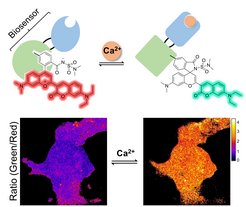Introducing Color-Switching Fluorophores for Bioimaging
New biosensor enables quantification of analytes based on color of emitted light
Researchers in the Department of Chemical Biology at the Max Planck Institute for Medical Research in Heidelberg have developed a new class of color-switching fluorophores. They enable the design of ratiometric biosensors for live-cell bioimaging. These fluorophores represent a new platform for the generation of biosensors and bioassays and will become important for the quantification of biochemical processes in living cells. The study was published in Angewandte Chemie in August.
The quantification of biomolecules and biological activities is key for an understanding of cellular processes. The Department of Chemical Biology has in the past developed numerous biosensors and fluorescent probes for such quantifications. The majority of these sensors were based on ratiometric imaging with two different synthetic fluorophores that needed to be attached to the sensor. However, specific labeling of such biosensors with two synthetic fluorophores in living cells represents an enormous technical challenge.

“Our goal was to develop a ratiometric sensor that would not need double labeling”, says Lu Wang, first author of the paper and postdoc in the Department of Chemical Biology. To achieve this goal, he developed a new class of fluorophores, which reversibly switch between a green and red fluorescent form via an intramolecular reaction, a so-called spirocyclization. Importantly, the equilibrium of spirocyclization is environmentally sensitive and can directly be measured by determining the ratio of red to green fluorescence. Julien Hiblot, senior scientist in the Department of Chemical Biology and together with Lu Wang first author of the paper, then exploited these fluorophores for the creation of a new biosensor for the important cellular messenger calcium. For this, he designed a protein-based biosensor that, once the color-shifting fluorophore is attached, changes the color of the emitted light in the presence of calcium. Furthermore, the two scientists developed ratiometric fluorescent probes for numerous other bioassays. In some cases they achieved 2400-fold fluorescence ratio changes upon binding of the analyte. The magnitude of these color changes is dramatically higher than those of any other biosensors previously developed in the Department of Chemical Biology, greatly facilitating quantifications.
“This work represents a conceptual advance and outlines a path for the development of semi-synthetic sensors based on a combination of molecular and protein engineering”, says Dr. Hiblot. Future work by Drs. Wang and Hiblot will focus on the development of other color-shifting biosensors and their applications towards the quantification of central biological processes in living cells. And both researchers expect that other scientists will snap up this new molecular tool to shed (color-shifting) light on their research problems.
